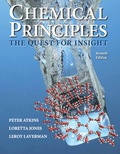
Concept explainers
Interpretation:
Molecular formula of the eugenol has to be determined.
Concept Introduction:
Mole is S.I. unit. The number of moles is calculated as ratio of mass of compound to molar mass of compound.
The expression to relate number of moles, mass and molar mass of compound is as follows:
Empirical formula represents simplest positive integer ratio of atoms in the compound. It only gives proportions of elements in compound. Molecular formula consists of
Answer to Problem 3B.42E
Molecular formula of the eugenol is
Explanation of Solution
The conversion factor to convert
Expression for ideal gas equation is as follows:
Rearrange equation (1) to calculate
Substitute
The expression to relate number of moles, mass and molar mass is as follows:
Rearrange equation (3) to calculate molar mass of compound.
Substitute
In
In
The expression to relate number of moles of
Rearrange equation (5) to calculate mass of
Substitute
The expression to relate number of moles of
Substitute
Mass of
The expression to relate number of moles of
Substitute
Preliminary formula for hydrocarbon is formed with moles of
Each of subscript of
Empirical mass from empirical formula can be calculated as follows:
Molar mass and empirical formula are related by formula as follows:
Rearrange equation (9) to calculate
Substitute
Molecular formula of the eugenol is
Want to see more full solutions like this?
Chapter 3 Solutions
EBK CHEMICAL PRINCIPLES
- Given that a sample of air is made up of nitrogen, oxygen, and argon in the mole fractions 0.78 N2, 0.21 O2, and 0.010 Ar, what is the density of air at standard temperature and pressure?arrow_forwardA 1-L sample of CO initially at STP is heated to 546 K. and its volume is increased to 2 L. (a) What effect do these changes have on the number of collisions of the molecules of the gas per unit area of the container wall? (b) What is the effect on the average kinetic energy of the molecules? (c) What is the effect on the root mean square speed of the molecules?arrow_forward
 Principles of Modern ChemistryChemistryISBN:9781305079113Author:David W. Oxtoby, H. Pat Gillis, Laurie J. ButlerPublisher:Cengage Learning
Principles of Modern ChemistryChemistryISBN:9781305079113Author:David W. Oxtoby, H. Pat Gillis, Laurie J. ButlerPublisher:Cengage Learning Chemistry: Principles and ReactionsChemistryISBN:9781305079373Author:William L. Masterton, Cecile N. HurleyPublisher:Cengage Learning
Chemistry: Principles and ReactionsChemistryISBN:9781305079373Author:William L. Masterton, Cecile N. HurleyPublisher:Cengage Learning Chemistry: The Molecular ScienceChemistryISBN:9781285199047Author:John W. Moore, Conrad L. StanitskiPublisher:Cengage Learning
Chemistry: The Molecular ScienceChemistryISBN:9781285199047Author:John W. Moore, Conrad L. StanitskiPublisher:Cengage Learning General, Organic, and Biological ChemistryChemistryISBN:9781285853918Author:H. Stephen StokerPublisher:Cengage Learning
General, Organic, and Biological ChemistryChemistryISBN:9781285853918Author:H. Stephen StokerPublisher:Cengage Learning Chemistry & Chemical ReactivityChemistryISBN:9781133949640Author:John C. Kotz, Paul M. Treichel, John Townsend, David TreichelPublisher:Cengage Learning
Chemistry & Chemical ReactivityChemistryISBN:9781133949640Author:John C. Kotz, Paul M. Treichel, John Townsend, David TreichelPublisher:Cengage Learning Chemistry & Chemical ReactivityChemistryISBN:9781337399074Author:John C. Kotz, Paul M. Treichel, John Townsend, David TreichelPublisher:Cengage Learning
Chemistry & Chemical ReactivityChemistryISBN:9781337399074Author:John C. Kotz, Paul M. Treichel, John Townsend, David TreichelPublisher:Cengage Learning





